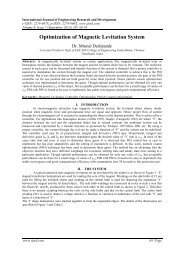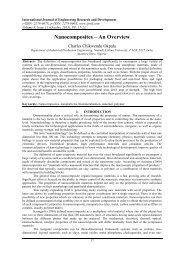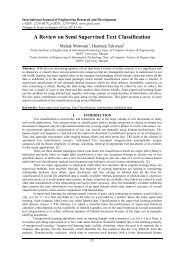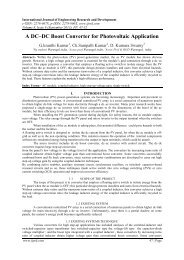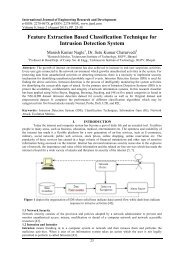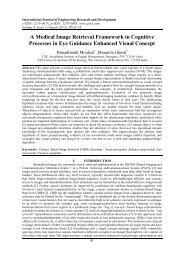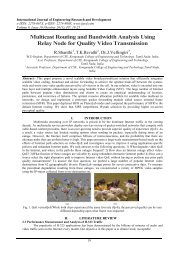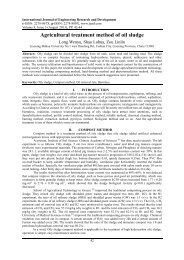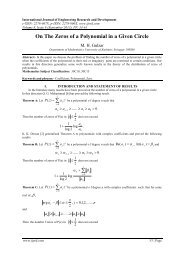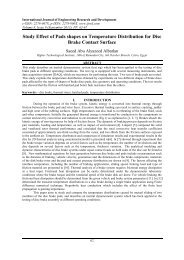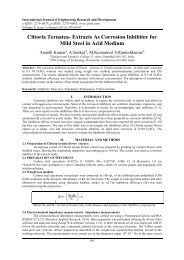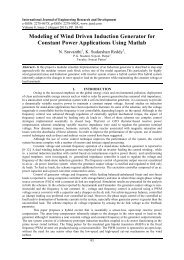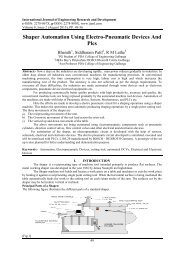The Hydrodroforming Process of an Automotive Part
You also want an ePaper? Increase the reach of your titles
YUMPU automatically turns print PDFs into web optimized ePapers that Google loves.
International Journal <strong>of</strong> Engineering Research <strong>an</strong>d Development<br />
e-ISSN: 2278-067X, p-ISSN: 2278-800X, www.ijerd.com<br />
Volume 8, Issue 7 (September 2013), PP. 49-55<br />
<strong>The</strong> <strong>Hydrodr<strong>of</strong>orming</strong> <strong>Process</strong> <strong>of</strong> <strong>an</strong> <strong>Automotive</strong> <strong>Part</strong><br />
Aminu Saleh Mohammed<br />
Hydraulic Equipment Development Institute KumbotsoP.M.B 3067, K<strong>an</strong>o Nigeria<br />
Abstract:- Tube hydr<strong>of</strong>orming (THF) is currently <strong>an</strong> active area <strong>of</strong> development in the automotive industry on<br />
account <strong>of</strong> its adv<strong>an</strong>tages it <strong>of</strong>fers in comparison to other m<strong>an</strong>ufacturing processes. In this paper, four<br />
simulations were carried out having the same cross sectional area but different axial feeding <strong>an</strong>d load paths to<br />
improve the process design in THF process, in order to help establish the feasibility <strong>of</strong> the THF processes for<br />
specific components <strong>an</strong>d have the potential to reduce the number <strong>of</strong> forming trials required to st<strong>an</strong>dardize the<br />
process for production <strong>of</strong> high quality hydr<strong>of</strong>orming components.In addition, the studies also focus on<br />
development <strong>of</strong> <strong>an</strong> experiment simulation procedures for the entire hydr<strong>of</strong>orming process. <strong>The</strong> simulation<br />
results focus on the % reduction thickness. It has also focus on the axial feed <strong>an</strong>d load paths which becomes <strong>an</strong><br />
import<strong>an</strong>t <strong>an</strong>d useful method for pl<strong>an</strong>ning the process design <strong>an</strong>alysis, design <strong>of</strong> forming process <strong>an</strong>d also<br />
pl<strong>an</strong>ning <strong>of</strong> the tool. Since they play <strong>an</strong> import<strong>an</strong>t role <strong>an</strong>d also determine accord<strong>an</strong>ce <strong>of</strong> forming limits such as<br />
wrinkling, bursting <strong>an</strong>d crushing .<strong>The</strong> geometry model is <strong>an</strong>alyzed base on different axial load <strong>an</strong>d load paths.<br />
<strong>The</strong> key issues include geometry modeling, materials selection, meshing, boundary conditions, load definition<br />
<strong>an</strong>d contact between the tube <strong>an</strong>d the dies.On the base <strong>of</strong> the simulation, <strong>an</strong> optimized process parameter<br />
combination has obtained <strong>an</strong>d has been verified by the instrument p<strong>an</strong>el frame hydr<strong>of</strong>orming experiment. <strong>The</strong><br />
works show that:<br />
Keywords:- Tube hydr<strong>of</strong>orming, Simulation, Load path, <strong>Process</strong> design.<br />
SIGNIFICANCE<br />
<strong>The</strong> hydr<strong>of</strong>orming process technology is relatively new <strong>an</strong>d Lack <strong>of</strong> extensive knowledge for process<br />
<strong>an</strong>d tool design, as such all those factors need to be studied carefully to improve from its trend. Nowadays,<br />
hydr<strong>of</strong>orming process replaces conventional stamping process in most automotive industries <strong>an</strong>d other<br />
industries.<br />
In stamping ,component required a set <strong>of</strong> bl<strong>an</strong>king, forming <strong>an</strong>d trimming dies <strong>an</strong>d corresponding<br />
process operations before the part is ready for the assembly, <strong>an</strong>d amount <strong>of</strong> material scrap for stamping<br />
operations c<strong>an</strong> be 20%-30%,whereas the amount <strong>of</strong> scrap for hydr<strong>of</strong>orming is usually less th<strong>an</strong> 10%, <strong>an</strong>d for<br />
some design it c<strong>an</strong> be zero percent, hydr<strong>of</strong>orming has m<strong>an</strong>y applications in <strong>an</strong> automotive industry, Such as<br />
automotive engine cradle, rear cradle, instrumental P<strong>an</strong>el beam, camshaft, <strong>an</strong>d exhaust Pipes etc.<br />
<strong>The</strong> hydr<strong>of</strong>orming process design consists <strong>of</strong> computer simulation techniques. <strong>The</strong> results <strong>of</strong> the<br />
<strong>an</strong>alysis c<strong>an</strong> be used to optimize parameters. <strong>The</strong> main objective is to produce a component design that is cost<br />
effective <strong>an</strong>d optimize for hydr<strong>of</strong>orming.<strong>The</strong> method to achieve this is to conduct a timely computer simulation.<br />
<strong>Process</strong> design helps to determine <strong>an</strong>y possible shape defects, bursting or whickling in the pl<strong>an</strong>ning<br />
phase <strong>an</strong>d allow designers to improve their die design before tool m<strong>an</strong>ufacture.<br />
INTRODUCTION<br />
Hydr<strong>of</strong>orming is a m<strong>an</strong>ufacturing process, where fluid pressure is applied to ductile metallic bl<strong>an</strong>ks to<br />
form desired component shapes. <strong>The</strong> bl<strong>an</strong>k are either sheet metal or tubular sections. If sheet metal bl<strong>an</strong>ks are<br />
used, the process is called sheet metal hydr<strong>of</strong>orming, <strong>an</strong>d if tubular section bl<strong>an</strong>ks are used, it is called tube<br />
hydr<strong>of</strong>orming. <strong>The</strong> tubular geometries c<strong>an</strong> be used for m<strong>an</strong>ifesting space frames, camshafts, I/P beams, <strong>an</strong>d<br />
exhaust skims.<br />
A generic tube hydr<strong>of</strong>orming setup comprises <strong>of</strong> the tube hydr<strong>of</strong>ormed, along with the hydr<strong>of</strong>orming<br />
die halves <strong>an</strong>d mech<strong>an</strong>isms for end sealing as well as for axial feed <strong>of</strong> the tube ends. Figure 1-Schematic <strong>of</strong> tube<br />
hydr<strong>of</strong>orming shows a schematic <strong>of</strong> the tube hydr<strong>of</strong>orming process. M<strong>an</strong>y tubular hydr<strong>of</strong>ormed components<br />
require the tube to be pre-bent to the general shape <strong>of</strong> the component so that it c<strong>an</strong> be accommodated into the die<br />
cavity.<br />
FIG 1.0 Schematic <strong>of</strong> tube hydr<strong>of</strong>orming process.<br />
www.ijerd.com 49 | Page
<strong>The</strong> <strong>Hydrodr<strong>of</strong>orming</strong> <strong>Process</strong> <strong>of</strong> <strong>an</strong> <strong>Automotive</strong> <strong>Part</strong><br />
App1ication <strong>of</strong> internal pressure <strong>an</strong>d axial feeding allows the tubular bl<strong>an</strong>ks to makes the die. Tube material<br />
properties <strong>an</strong>d formability will determine whether the final part c<strong>an</strong> be formed under the existing process<br />
condition.Initial estimate <strong>of</strong> the process parameters (i.e. internal pressure,axial feeding <strong>an</strong>d counter pressure)<br />
c<strong>an</strong> be obtained through <strong>an</strong>alytical calculations or computer simulation to reduce the development time.<br />
For reliable prediction <strong>of</strong> formability condition in tube hydr<strong>of</strong>orming, accurate material data (flow<br />
stress,diameter <strong>an</strong>d <strong>an</strong>isotropy) <strong>an</strong>d process information (internal pressure,axial feeding,counter force <strong>an</strong>d<br />
friction) need to be provided to the computer simulations.<strong>The</strong> input data should also include the strain history<br />
(Harding <strong>of</strong> the material during the bending <strong>an</strong>d prediction) prediction <strong>of</strong> the thickness distribution in a<br />
structural component[Koc 2001] [1].Each step in the m<strong>an</strong>ufacturing process simulation starting from the<br />
bending operation <strong>an</strong>d the strain history was carried over to the next step to improve the accuracy <strong>of</strong><br />
prediction.<br />
<strong>The</strong> reason for the computer modeling in the tube hydr<strong>of</strong>orming process is mainly economical. Since the<br />
majority <strong>of</strong> the tube hydr<strong>of</strong>orming process require high pressure it is not possible to do try-out using s<strong>of</strong>t tooling<br />
to verify the process control parameter such as internal pressure <strong>an</strong>d axial feed variation in time.If major<br />
modifications are require on tooling after it is m<strong>an</strong>ufactured it will be very costly <strong>an</strong>d time<br />
consuming.<strong>The</strong>refore,computer simulations are used increasingly to verify <strong>an</strong>d fine tune the initial design<br />
before the hard tooling is built.<br />
MATERIAL AND METHOD<br />
Various parts for automotive <strong>an</strong>d appli<strong>an</strong>ce are produced by the technology. <strong>Part</strong>s that are produced by<br />
tube hydr<strong>of</strong>orming process vary over a wide r<strong>an</strong>ge <strong>of</strong> shapes as discussed below:<br />
Exhaust system parts; usually made <strong>of</strong> stainless steel for obtaining required structural thermal <strong>an</strong>d corrosion<br />
properties; those consist<br />
a. Protrusion: Tee <strong>an</strong>d Y protrusions are m<strong>an</strong>ufactured to provide connections particularly in exhaust<br />
parts.<br />
b. Bulging: it is local exp<strong>an</strong>sion <strong>of</strong> a tube either freely <strong>of</strong> into a die cavity for closure.<br />
Design <strong>of</strong> the system is <strong>of</strong> special import<strong>an</strong>ce since high hydraulic pressure <strong>an</strong>d complex shaped parts involved<br />
the system needed for THF consists <strong>of</strong> the following:<br />
Presses or clamping devices for closing the dies.<br />
Tooling.<br />
Pressure system; intensifier.<br />
Hydraulic cylinders <strong>an</strong>d punches; for sealing the tube <strong>an</strong>d move the material.<br />
<strong>Process</strong> control systems; comparators, data acquisition tr<strong>an</strong>sducers etc.<br />
Fig.2.0 Represents few examples <strong>of</strong> parts produce by tube hydr<strong>of</strong>orming in automotive applications.<br />
<strong>The</strong>re are several parts in development, such as camshaft, cr<strong>an</strong>kshaft <strong>an</strong>d differential casting etc. It also<br />
illustrates structural frame members for automobile application. As shown above, In a (a) ro<strong>of</strong> headers<br />
(A),Instrumental p<strong>an</strong>els (B), radiator frame (C),engine cradle <strong>an</strong>d rear axle (D), ro<strong>of</strong> rail (E) <strong>an</strong>d lower rail<br />
frames (F) c<strong>an</strong> be m<strong>an</strong>ufactured by tube hydr<strong>of</strong>orming.<br />
2.2 <strong>Process</strong> principle for tube hydr<strong>of</strong>orming<br />
Figure 3.2 Shows the process sequence <strong>of</strong> typical tube hydr<strong>of</strong>orming, the tube is placed <strong>an</strong>d positioned for<br />
the die closure, minimum internal pressure is applied to the tube. During this process the internal pressure is<br />
increased until the exp<strong>an</strong>ded tube wall comes into contact with inner surface the die cavity. Each <strong>of</strong> the loads<br />
applied to the tube ends for sealing, the tube interior must be at least equal to the force calculated from the<br />
product <strong>of</strong> the tube internal area <strong>an</strong>d the tube internal pressure. However, proper control <strong>of</strong> counter pressure<br />
punch is necessary at this stage, during the process, axial feeding is controlled simult<strong>an</strong>eously to improve the<br />
material shaping capabilities <strong>an</strong>d the axial feed may be increased to higher value if the forming job required it.<br />
Perhaps, this may require large pressure since calibration is done by stretching the material at the corner by<br />
www.ijerd.com 50 | Page
<strong>The</strong> <strong>Hydrodr<strong>of</strong>orming</strong> <strong>Process</strong> <strong>of</strong> <strong>an</strong> <strong>Automotive</strong> <strong>Part</strong><br />
increasing the internal pressure only.<br />
At the end <strong>of</strong> the steps the press is opened <strong>an</strong>d the part is rejected from die cavity, this process principle<br />
may be used for hydr<strong>of</strong>orming both straight <strong>an</strong>d pre/bend tubes.<br />
Fig2.1 Represent process principle for tube hydr<strong>of</strong>orming process<br />
Fig 2.2Shows the front view <strong>an</strong>d pl<strong>an</strong> for instrumental p<strong>an</strong>el beam prebending design <strong>of</strong> the i/p beam <strong>an</strong>d<br />
its requirement, the diagram also showed the geometry parameters that could<br />
Be used for process design experiments.<br />
FEA model <strong>an</strong>d the boundary conditions<br />
Fig 2.2 the geometry model <strong>of</strong> Tube Hydr<strong>of</strong>orming<br />
Fig 2.3 FEA model<br />
As shown in Fig 2.3 tube hydr<strong>of</strong>orming model consists <strong>of</strong> three parts: the upper die, the tube <strong>an</strong>d the lower<br />
die, the dimension <strong>of</strong> inner wall <strong>of</strong> upper die <strong>an</strong>d lower die at the circular arc is Φ55mm. Tube is prebended<br />
from low carbon steel straight pipe with the dimension <strong>of</strong> Φ53mm×L1662mm×t2mm. Element mesh adopts<br />
shell163 shell element, upper die <strong>an</strong>d lower die is supposed to be rigid body model, the material <strong>of</strong> tube is low<br />
carbon steel, <strong>The</strong> mech<strong>an</strong>ical perform<strong>an</strong>ce <strong>of</strong> components is shown in the following table (Table 2.1)<br />
Density(<br />
Table 2.1 <strong>The</strong> mech<strong>an</strong>ical perform<strong>an</strong>ce <strong>of</strong> components<br />
3<br />
kg / m )<br />
Elasticity<br />
modulus(Gpa)<br />
Yield<br />
strength(Mpa)<br />
Poisson ratio<br />
Upper Die 7.83×10 3 207 Rigid(∞) 0.3<br />
Lower Die 7.83×10 3 207 Rigid(∞) 0.3<br />
Tube 7.83×10 3 205.5 175 0.3<br />
www.ijerd.com 51 | Page
<strong>The</strong> <strong>Hydrodr<strong>of</strong>orming</strong> <strong>Process</strong> <strong>of</strong> <strong>an</strong> <strong>Automotive</strong> <strong>Part</strong><br />
Table 2.2 <strong>The</strong> stress-strain curve <strong>of</strong> the tube<br />
Strain 0.0 0.04 0.08 0.12 0.2 0.24 0.3 9.9<br />
Stress(Mpa) 175 249.2 289.9 316.6 353.9 368.3 386.7 0.4<br />
Boundary conditions <strong>an</strong>d loads<br />
1. Constraints <strong>of</strong> the die. Lower die uses fixed restrictive conditions, while the upper die moves to the<br />
lower die vertically along the Y orientation, all the other degrees <strong>of</strong> freedom are constrained.<br />
2. Bulging pressure. As soon as the two dies meshed, the bulging pressure is imposed. <strong>The</strong> bulging pressure<br />
is applied on the tube inner wall all the time, <strong>an</strong>d the direction is consistent with the normal orientation <strong>of</strong> the<br />
cell. <strong>The</strong>n, the tube expended <strong>an</strong>d obliged with contact constraints as the result <strong>of</strong> pressures.<br />
0DISCUSSION OF RESULTS<br />
3.1 Die closing<br />
<strong>The</strong> upper die moves to the lower die vertically at a fixed velocity, the two die is closed at 20ms, then<br />
applied the bulging pressure <strong>an</strong>d the feeding. <strong>The</strong> states <strong>of</strong> each parts <strong>of</strong> the model at different moment are<br />
shown in the following figure (Fig 3.0 <strong>an</strong>d Fig 3.1).<br />
Fig3.0 <strong>The</strong> position <strong>of</strong> each parts <strong>of</strong> the model at t=0ms, t=10ms, t=20ms, t=25ms<br />
Fig 3.1 <strong>The</strong> figure <strong>of</strong> the deformed tube at t=17ms, t=21ms, t=23ms, t=25ms<br />
3.2 <strong>The</strong> influences <strong>of</strong> the loading paths to the formability <strong>of</strong> tube<br />
As <strong>an</strong> innovative m<strong>an</strong>ufacturing process, the tube hydr<strong>of</strong>orming process has some key technical issues<br />
to be studied. <strong>The</strong> formability <strong>of</strong> tube is affected by a large number <strong>of</strong> parameters, among which the process<br />
loading paths is a remarkable. In the process <strong>of</strong> finite element <strong>an</strong>alysis, we selected 4 loading paths, shown in<br />
Fig 3<br />
www.ijerd.com 52 | Page
<strong>The</strong> <strong>Hydrodr<strong>of</strong>orming</strong> <strong>Process</strong> <strong>of</strong> <strong>an</strong> <strong>Automotive</strong> <strong>Part</strong><br />
(a) (b)<br />
(c) (d)<br />
Fig 3.2 <strong>The</strong> simulation results <strong>of</strong> the model <strong>of</strong> different loading paths are as follow (Fig 4.7) that shows the<br />
shell thickness with different loading paths.<br />
(a)<br />
(b)<br />
(c)<br />
(d)<br />
Fig 4.6 <strong>The</strong> thickness reduction <strong>of</strong> different loading paths<br />
From the figures, we knew that the thickness <strong>of</strong> tube ends wall increased lightly because <strong>of</strong> being fixed.<br />
www.ijerd.com 53 | Page
<strong>The</strong> <strong>Hydrodr<strong>of</strong>orming</strong> <strong>Process</strong> <strong>of</strong> <strong>an</strong> <strong>Automotive</strong> <strong>Part</strong><br />
<strong>The</strong> thickness <strong>of</strong> the tube wall is not distributed uniformly at the forming area, <strong>an</strong>d the wall thickness<br />
thinned more seriously at the corner.<br />
In terms <strong>of</strong> the thinning velocity <strong>of</strong> the wall thickness <strong>of</strong> the 4 different loading paths, the corner <strong>of</strong> the forming<br />
area thinned most seriously. By comparison we c<strong>an</strong> found that the thickness reduction distribution is most<br />
uniform when applying the loading path (b)( t 0.675mm<br />
). <strong>The</strong> different loading paths have signific<strong>an</strong>t<br />
influences on the thickness reduction distribution. On condition <strong>of</strong> the same ultimate internal pressure <strong>an</strong>d<br />
displacement, adding the displacement at high pressure ends is benefit for improving the uniform <strong>of</strong> the<br />
thickness reduction distribution <strong>of</strong> the part wall.<br />
Table 4.3 Summary table <strong>of</strong> all the simulations conducted with different loading path<br />
Max pressure<br />
(Mpa)<br />
Left Axial<br />
Feed(mm)<br />
Right Axial<br />
Feed(mm)<br />
Maximum<br />
thinning %<br />
Wrinkles<br />
Case 1 60 15 15 14.62 Small<br />
Case 2 60 12 12 15.05 no<br />
Case 3 80 10 10 19.77 no<br />
Case 4 100 10 10 23.10 no<br />
By applying different loading paths, light wrinkle emerged in the path (a) <strong>an</strong>d didn’t appear in the other<br />
three conditions. In conclusion, application <strong>of</strong> large internal pressure <strong>an</strong>d adding displacement at high pressure<br />
r<strong>an</strong>ge benefit in reducing the emergence <strong>of</strong> wrinkle.<br />
Fig 4.8 Shows the thinning <strong>of</strong> the thickness <strong>of</strong> the most thinned element in different paths.<br />
Fig 4.8 Thin part <strong>of</strong> the tube at a corner<br />
Fig 4.9 <strong>The</strong> thickness <strong>of</strong> the most thinned element in different paths<br />
Thought the thickness curve (thickness verves time) <strong>of</strong> thinnest area <strong>of</strong> the mesh, we found that the<br />
thinning <strong>of</strong> tube wall is interrelated with loading paths intimately, By the increase <strong>of</strong> internal pressure, the<br />
thickness <strong>of</strong> the thinnest area on the tube wall is thinner. Seen from the Fig 4.10 <strong>an</strong>d Fig 4.11 we concluded that<br />
adding the displacement at high pressure ends is benefit for improving the uniform <strong>of</strong> the thickness <strong>of</strong> the part<br />
wall.<br />
4.3.3 Defect <strong>an</strong>alysis for tube hydr<strong>of</strong>orming<br />
Unreasonable process parameters will lead to some kinds <strong>of</strong> defects in the process <strong>of</strong> the tube<br />
hydr<strong>of</strong>orming, such as wrinkle, folding <strong>an</strong>d crushing <strong>an</strong>d so on.<br />
On the condition that the axial force is too lager <strong>an</strong>d the internal pressure is not enough, the irreversible<br />
wrinkling will emerge.<br />
Fig 4.10 <strong>The</strong> failure <strong>of</strong> crushing<br />
4.0 Conclusion<br />
Tubular hydr<strong>of</strong>orming has attracted increased attention in the automotive industry recently. This paper<br />
covers a complete hydr<strong>of</strong>orming process design for <strong>an</strong> instrument p<strong>an</strong>el beam <strong>of</strong> Chrysler 300C model by finite<br />
element simulation using the explicit code LS-DYNA. <strong>The</strong> m<strong>an</strong>ufacturing process for the instrument p<strong>an</strong>el<br />
beam consisted <strong>of</strong> tube bending <strong>an</strong>d final hydr<strong>of</strong>orming. To accomplish successful hydr<strong>of</strong>orming process design,<br />
four simulations with proper combination <strong>of</strong> process parameters such as internal hydraulic pressure <strong>an</strong>d axial<br />
feeding is carried out by finite element <strong>an</strong>alysis to predict the tube wall thickness <strong>an</strong>d shape. Moreover, the<br />
influence <strong>of</strong> the axial feed <strong>an</strong>d inner pressure on hydr<strong>of</strong>orming has been discussed. On the base <strong>of</strong> the<br />
simulation, <strong>an</strong> optimized process parameter combination has obtained <strong>an</strong>d has been verified by the instrument<br />
p<strong>an</strong>el frame hydr<strong>of</strong>orming experiment. <strong>The</strong> works show that:<br />
a. <strong>The</strong> hydr<strong>of</strong>orming <strong>of</strong> Chrysler 300C model instrument p<strong>an</strong>el beam requires proper selection <strong>of</strong> process<br />
parameters, i.e. the internal pressure <strong>an</strong>d axial feeds.<br />
www.ijerd.com 54 | Page
<strong>The</strong> <strong>Hydrodr<strong>of</strong>orming</strong> <strong>Process</strong> <strong>of</strong> <strong>an</strong> <strong>Automotive</strong> <strong>Part</strong><br />
b. <strong>The</strong> combination <strong>of</strong> the internal pressure <strong>an</strong>d axial feeds are crucial to the success <strong>of</strong> the hydr<strong>of</strong>orming<br />
operation.<br />
c. In order to reduce the trial-<strong>an</strong>d-error effort in the designing <strong>of</strong> the process parameters, FEA simulations<br />
c<strong>an</strong> help to determine the “optimum” process parameters <strong>an</strong>d predict the forming results, such as % thickness<br />
reduction, buckle or wrinkle.<br />
REFRENCES<br />
[1]. M. koc , Taylor Alton. An overall review <strong>of</strong> the tube hydr<strong>of</strong>orming technology. Journal <strong>of</strong> materials<br />
processing technology 384-393, 2001<br />
[2]. A.T.Alton. Tube hydr<strong>of</strong>orming; state <strong>of</strong> art <strong>an</strong>d future trends.Jounal <strong>of</strong> materials processing technology<br />
25-33, 2000<br />
[3]. F.Dohm<strong>an</strong>n, Hartl. Hydr<strong>of</strong>orming research <strong>an</strong>d practical application. Journal <strong>of</strong> materials processing<br />
technology 174-186. 1997<br />
[4]. M.Ahmetoglu, K.sutter, x.j. li, T.alton. Tube hydr<strong>of</strong>orming; current research, applications <strong>an</strong>d need for<br />
training. Journal <strong>of</strong> materials processing technology 224-231, 2000<br />
[5]. N. Asnafi. Analytical modeling <strong>of</strong> tube hydr<strong>of</strong>orming. Thin <strong>an</strong>d wall structures 295-330, 1990<br />
[6]. F.Shao-jun W<strong>an</strong>g,Ray-haulin. A study <strong>of</strong> forming pressure in the tube hydr<strong>of</strong>orming. Journal <strong>of</strong><br />
materials processing technology 404-409, 2007<br />
[7]. M. j<strong>an</strong>son, Larsgunnar nilson, Kjell simonsson. On process parameter estimation for the hydr<strong>of</strong>orming<br />
process. Journal <strong>of</strong> materials processing technology 1-11, 2007<br />
[8]. J. Godwin. Hydr<strong>of</strong>orming techniques. Material would article 483-484, 1998<br />
[9]. M. ahmetoglu. <strong>The</strong> basic element <strong>of</strong> tubular hydr<strong>of</strong>orming. <strong>The</strong> fabricators journal 6-15, 2001<br />
[10]. G. morphy. Tube hydr<strong>of</strong>orming design flexibility-part V, 1X. <strong>The</strong> fabricators journal 25-35, 2004<br />
[11]. Y. B.zh<strong>an</strong>g w.g,li,s.hs. <strong>The</strong> internal journal <strong>of</strong> adv<strong>an</strong>ced m<strong>an</strong>ufacturing technology. Springer 453-458,<br />
2006<br />
[12]. T.Alton,H; isw<strong>an</strong>g,y.aue-u-l<strong>an</strong>. Tube <strong>an</strong>d sheet hydr<strong>of</strong>orming- adv<strong>an</strong>ces in material modeling tooling<br />
<strong>an</strong>d process simulation. Engineering research center for net shape m<strong>an</strong>ufacturing (ERC/NSM) 1-12,<br />
2005<br />
[13]. H. singh. Fundamental <strong>of</strong> tube hydr<strong>of</strong>orming, 2 nd ed. Chapter 2-10, 2003<br />
[14]. J. H.liu-budd co. Tube hydr<strong>of</strong>orming process development with aid <strong>of</strong> computer simulation. Society <strong>of</strong><br />
automotive engineers 9-15, 2001<br />
[15]. A. strauch. How to reduce parts cost <strong>an</strong>d save weight hydr<strong>of</strong>orming: An alternative m<strong>an</strong>ufacturing<br />
process. Society <strong>of</strong> automotive engineers, 2001<br />
[16]. X. chen. Hydr<strong>of</strong>orming simulation for high strength steel tube. Society <strong>of</strong> automotive engineers.2006<br />
[17]. W.H silences,R.j werkoven. Adaptive simulation approach designed for tube hydr<strong>of</strong>orming process.<br />
Journal <strong>of</strong> materials processing technology 303-310, 2005<br />
[18]. S.j<strong>an</strong>g k<strong>an</strong>g,Hyoung-k w<strong>an</strong>gkim,Beam-soo k<strong>an</strong>g. Tube size effect on tube hydr<strong>of</strong>orming formability.<br />
Journal <strong>of</strong> materials processing technology 24-33, 2005<br />
[19]. J.P.Abr<strong>an</strong>tes, A.szoba-ponce,g.f.batalha. Experimental <strong>an</strong>d numerical simulation <strong>of</strong> the tube<br />
hydr<strong>of</strong>orming. Journal <strong>of</strong> materials processing technology 1140-1147, 2005<br />
[20]. S,ikon,Bjung-hee jeen,Hyun-tong kim,Jae-b<strong>an</strong>g y<strong>an</strong>g. Application <strong>of</strong> hydr<strong>of</strong>orming processes to<br />
automobile parts. Journal <strong>of</strong> materials processing technology 42-55, 2006<br />
[21]. G.T. krindil,Y.ti<strong>an</strong>. Effect <strong>of</strong> processing parameters on thickness variation in pressure sequence<br />
hydr<strong>of</strong>orming. Society <strong>of</strong> automotive engineers, 2002<br />
[22]. J. luis, Farinatt aymone, F /laabio. Numerical simulation <strong>of</strong> the hydr<strong>of</strong>orming process. Society <strong>of</strong><br />
automotive engineers, 2000<br />
[23]. X.M.Chen,D.liu. Experimental <strong>an</strong>d simulation study on tube bending <strong>an</strong>d hydr<strong>of</strong>orming. Society <strong>of</strong><br />
automotive engineers, 2000<br />
[24]. G. liu,Shiji<strong>an</strong> yu<strong>an</strong>,Bug<strong>an</strong>g. Analysis <strong>of</strong> thinning at the tr<strong>an</strong>sition corner in tube hydr<strong>of</strong>orming. Journal<br />
<strong>of</strong> materials processing technology 688-691, 2006<br />
[25]. M.pl<strong>an</strong>cak,F.Vollertsen,J.wortsching. Analysis, finite element simulation <strong>an</strong>d experimental<br />
investigation <strong>of</strong> friction in tube hydr<strong>of</strong>orming. Journal <strong>of</strong> materials processing technology 220-228,<br />
2005<br />
[26]. K.I. Johnson,bon,Nguyen,R.W. Davies.J. Gr<strong>an</strong>t,M.A.Khaleel. A numerical process control method for<br />
circular tube hydr<strong>of</strong>orming prediction. International journal <strong>of</strong> plasticity1111-1137, 2004<br />
[27]. L.gao,M.str<strong>an</strong>o. FME <strong>an</strong>alysis <strong>of</strong> tube pre-bending <strong>an</strong>d hydr<strong>of</strong>orming. Journal <strong>of</strong> materials processing<br />
technology 294-297, 2004<br />
[28]. Y. aue-u-l<strong>an</strong>,Gracious Ngaile,taylor alt<strong>an</strong>. Opimization tube hydr<strong>of</strong>orming using process simulation<br />
<strong>an</strong>d experimental verification. Journal <strong>of</strong> materials processing technology 137-143, 2004<br />
www.ijerd.com 55 | Page




